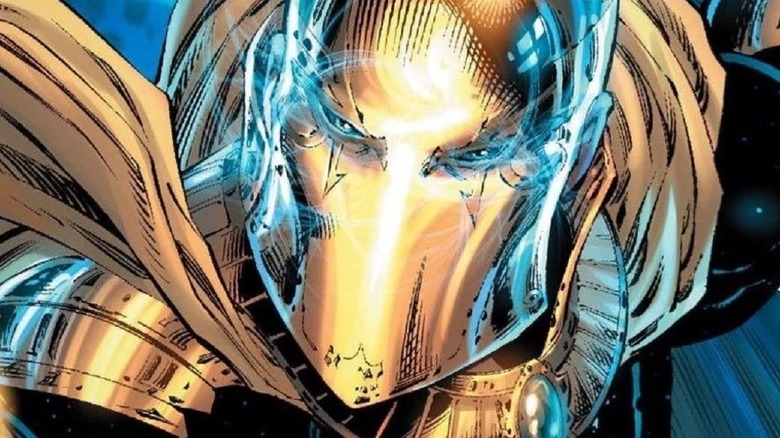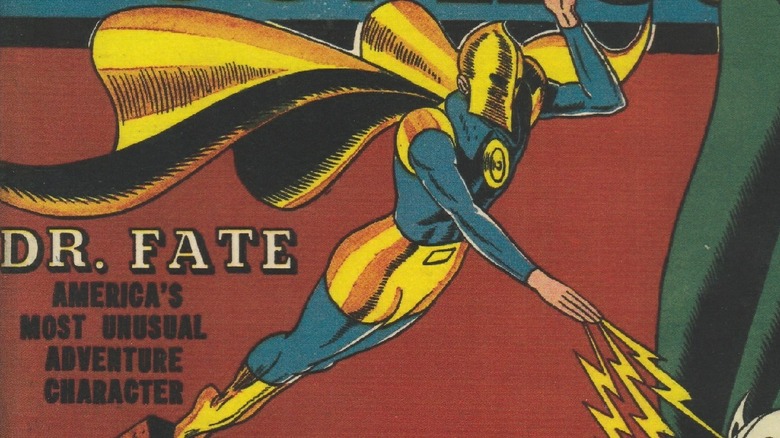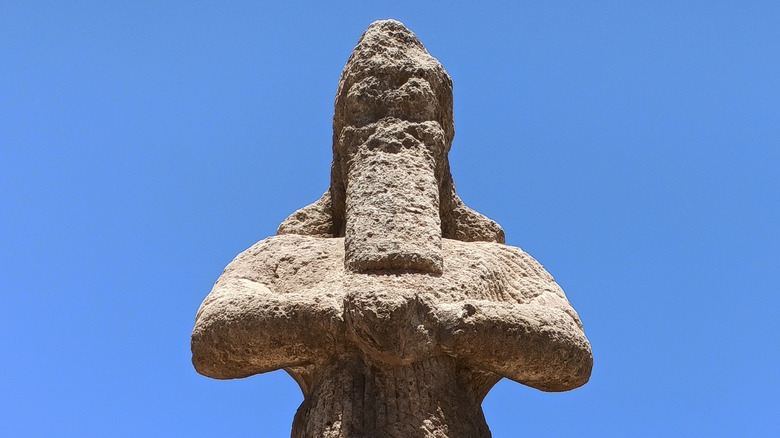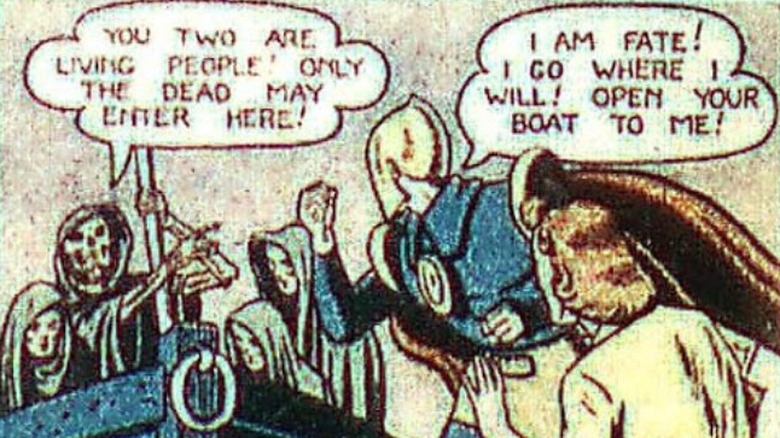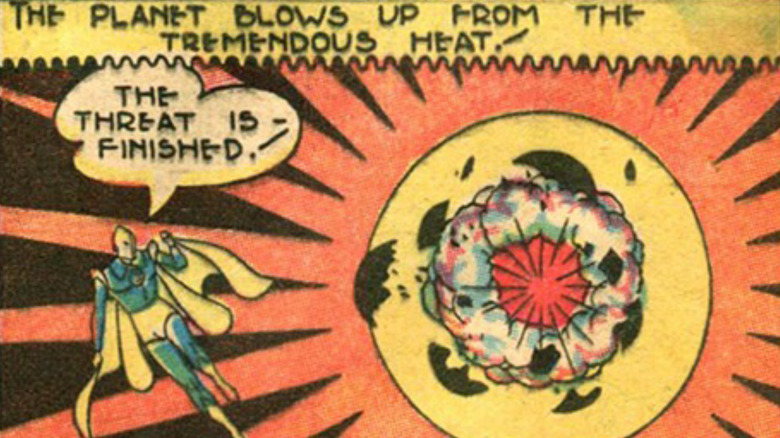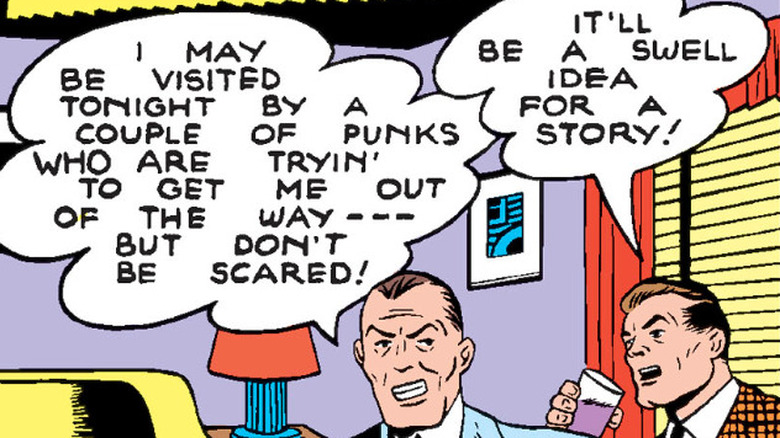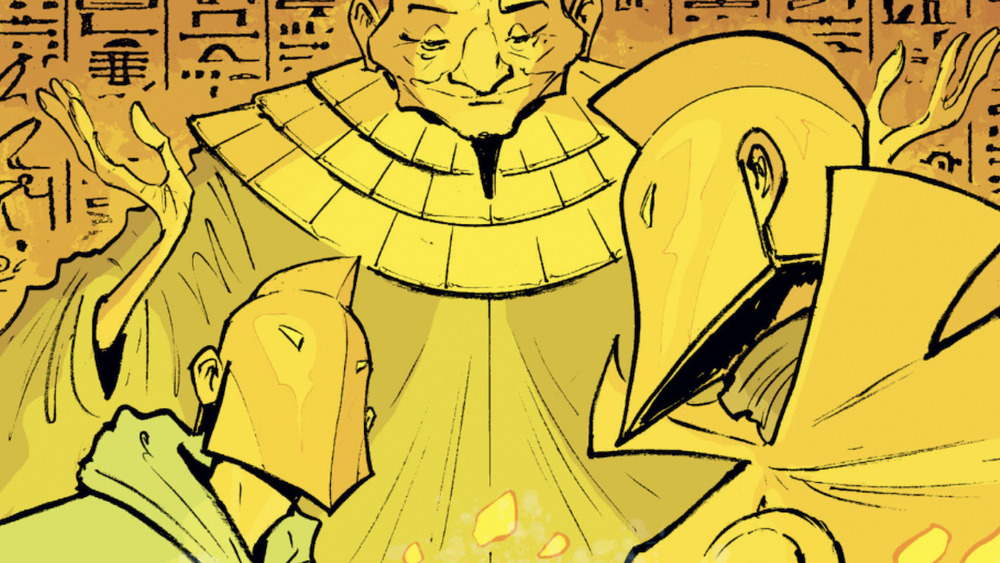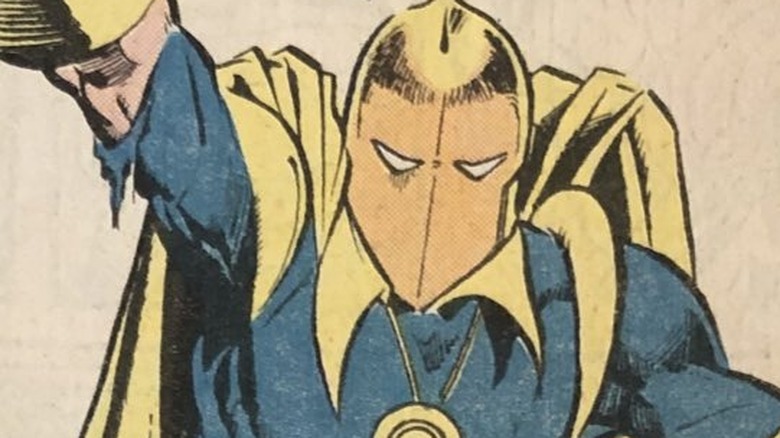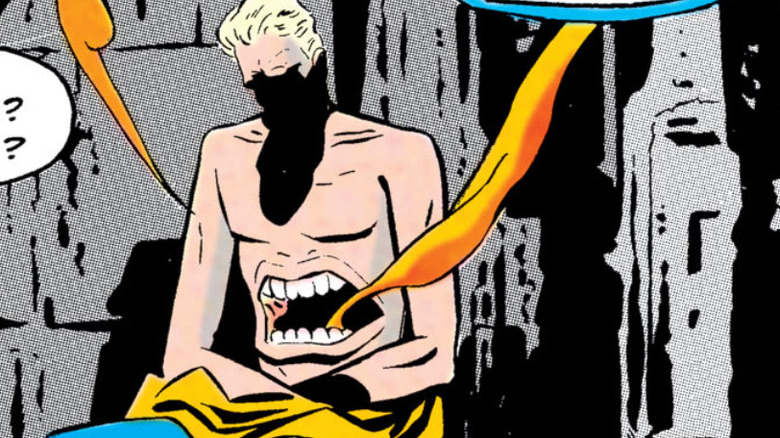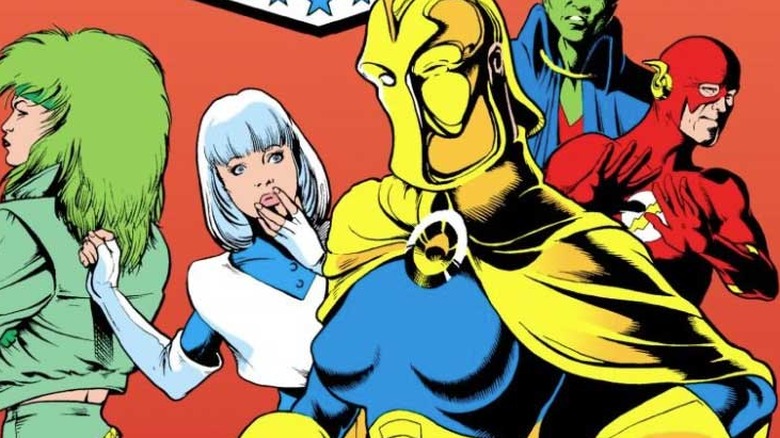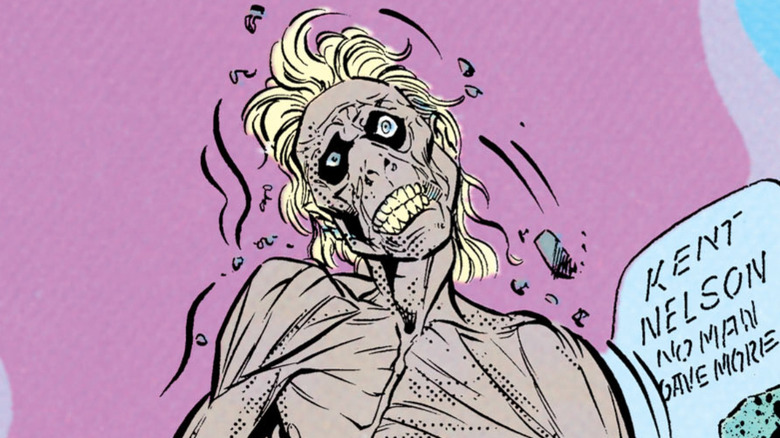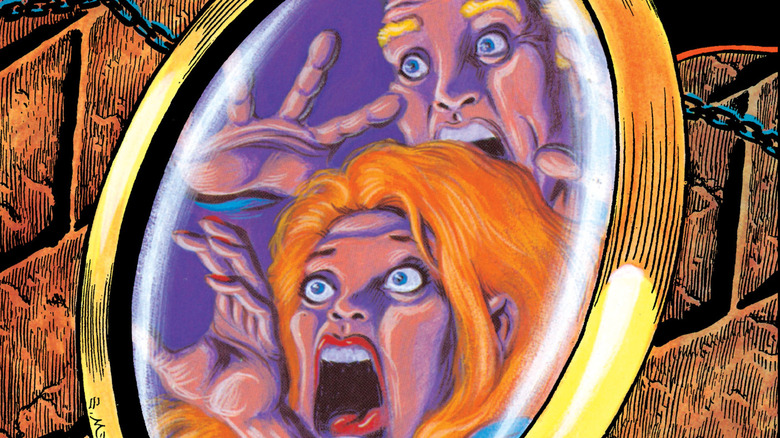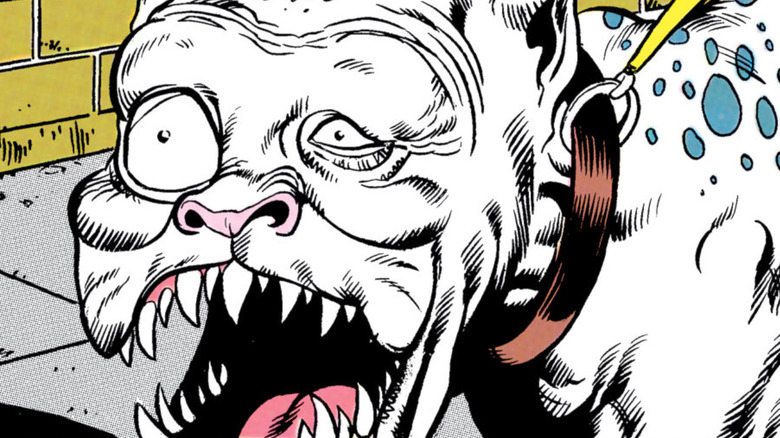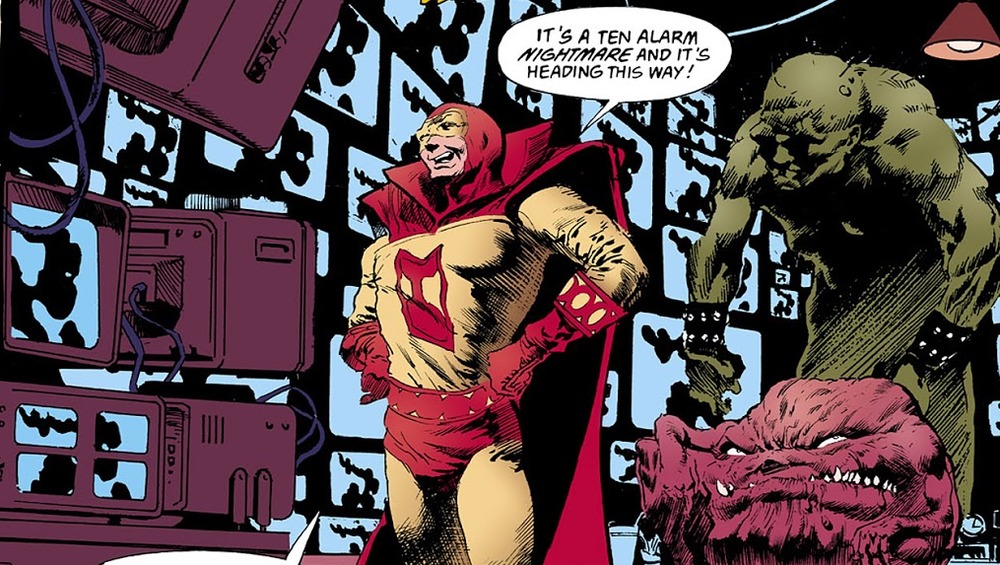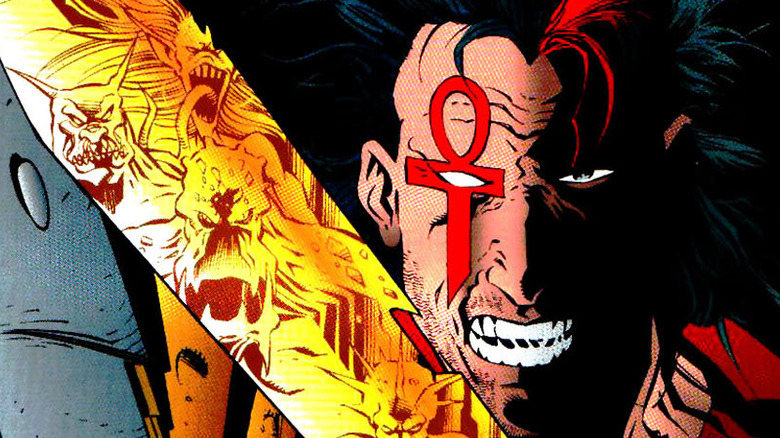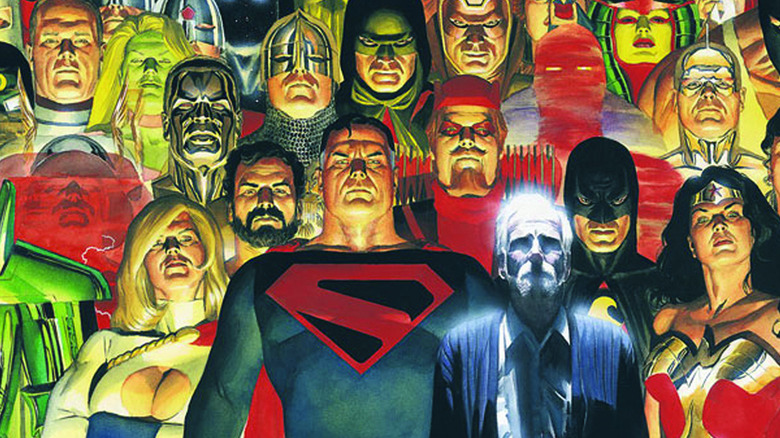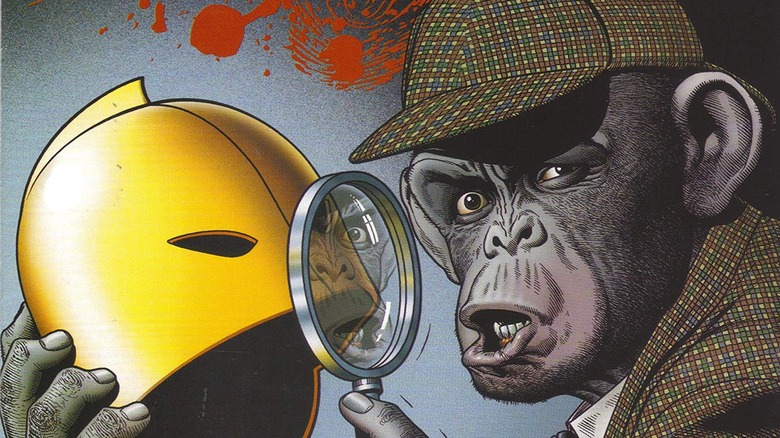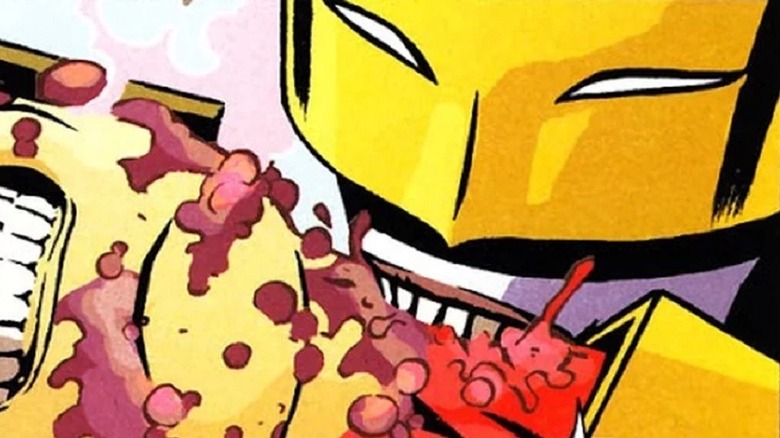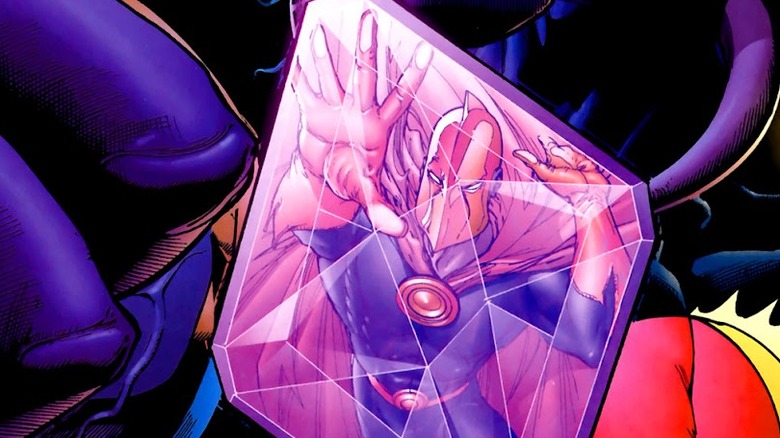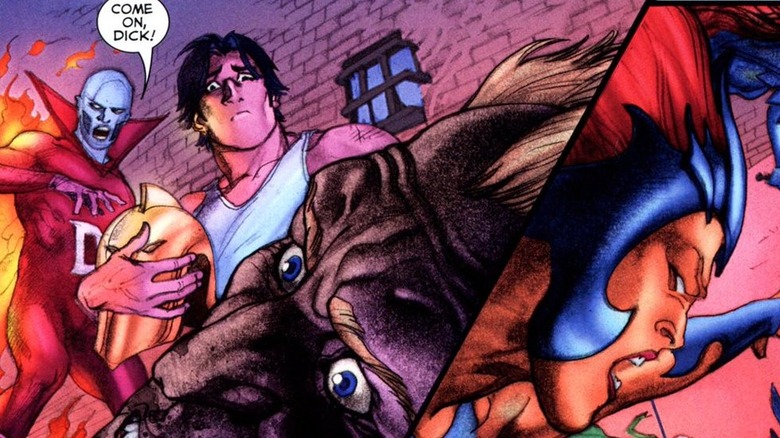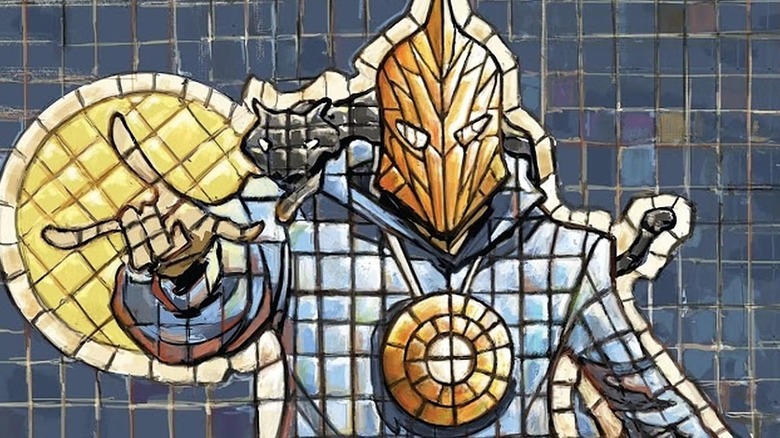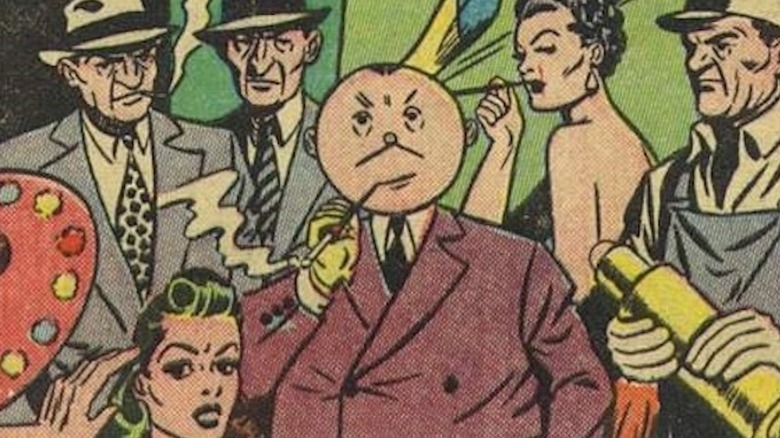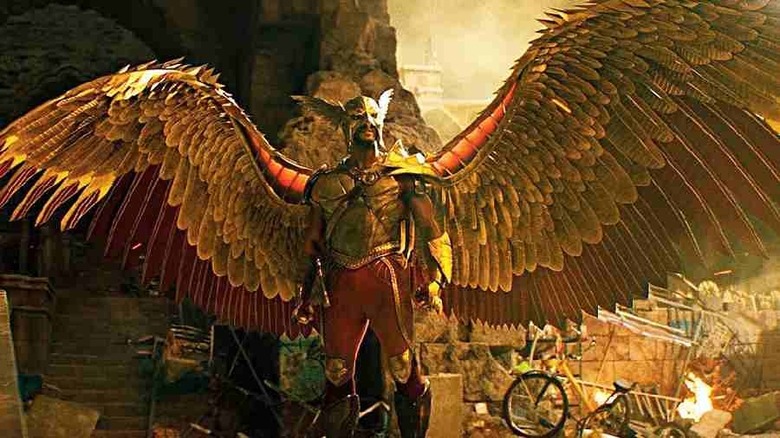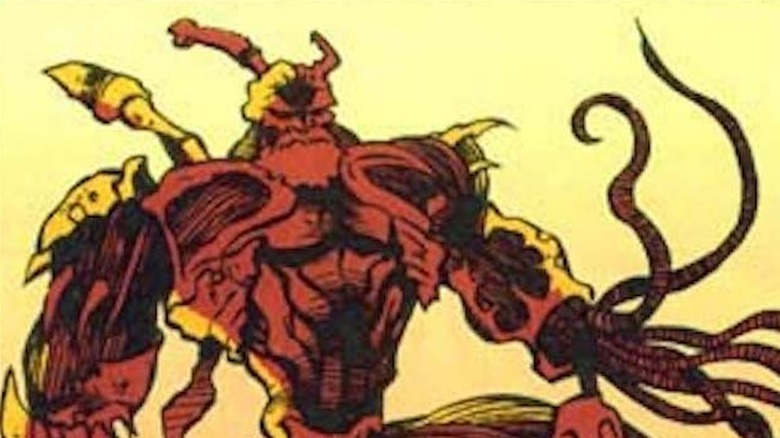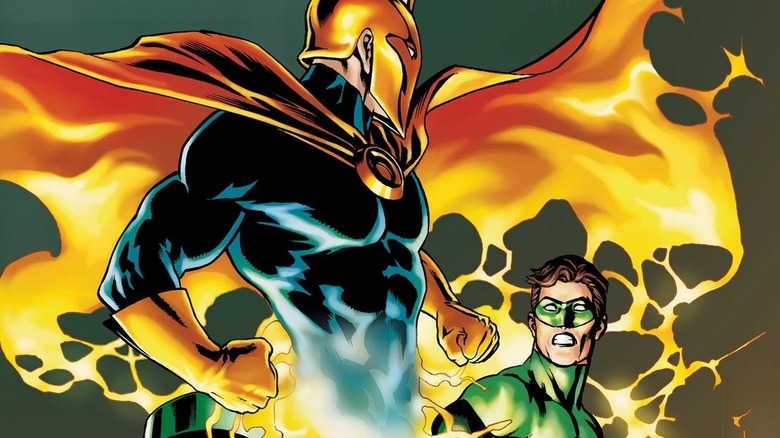DC Comics' Doctor Fate: Facts Only Huge Fans Know
Doctor Fate is one of the DC Universe's oldest and most important heroes. First appearing in a comic in the 1940s, he traces his origins all the way back to Ancient Egypt. Doctor Fate participated in the first building blocks of inter-comics continuity when he joined the heroes of other series, including Superman, Batman, and the Flash, in forming the Justice Society of America.
Doctor Fate's powers come from the Helmet of Nabu. Nabu was an ancient, otherworldly wizard whose successors became some of the most powerful sorcerers in the universe. Since then, Doctor Fate's joined the Justice Society and multiple Justice Leagues, passed his powers on to dozens of heirs, saved the world more times than we can count, and appeared in more comics than we could read in a lifetime. Now he's jumping to the big screen, with Pierce Brosnan playing him in "Black Adam."
That's a lot to cover. Fortunately, your friends here at Looper have sorted through all these thousands of pages of comics to find the most exciting, juiciest, and just plain weirdest stories from the career of Doctor Fate.
Doctor Fate explained magic with science
Doctor Fate first appeared in 1940 in a story for "More Fun Comics" #55 with evocative art by Howard Sherman and a story by Gardner Fox. Fox would become one of the most important writers in the DC Universe, creating the Flash, Hawkman, and the Justice League. He began his career writing for science fiction magazines and remained fascinated with the genre throughout his life, introducing sci-fi concepts like the multiverse in "The Flash of Two Worlds" and peppering his stories with little science lessons.
Even though Doctor Fate, with its story of ancient magic and monsters from beyond time and space, seems like an ideal setup for a dark fantasy series (which is how most future writers would treat it), Fox wasn't able to resist returning to his science fiction roots. In his first appearance, Fox describes Doctor Fate as a "physicist extraordinary" and Fate himself explains one of his magical feats this way: "I merely released the energy atoms comprising the vase — changing them into atoms of dust." Look, we just said it was science, not accurate science.
Nabu is named after a god of Assyrian mythology
Fox and Sherman finally revealed how Fate learned all these magical or scientific powers in "More Fun Comics" #67. Young Kent Nelson was accompanying his father Sven on an archaeological dig in the pyramids. There, Kent finds the perfectly preserved body of an ancient Egyptian priest named Nabu, who compels Kent to swing a lever, releasing a gas that brings Nabu back to life. But the tomb also contains another, poisonous gas that kills Sven. For the next several years, Nabu trains the now-orphaned boy in his secrets.
Comic fans mark this as Nabu's first appearance, but his name is much, much older. Sometimes spelled "Nebo," it appears in some of the most ancient records discovered in the ruins of Babylon and Assyria, and even in the Bible. The New International Encyclopedia describes Nabu as one of the most important gods in Babylonian religion, the son of the gods' ruler Marduk, and the god of wisdom and writing. This identifies him with the equivalent Egyptian god, Thoth, which makes it fitting that Nabu identifies himself as "the wise servant of Thoth" in #3 of the most recent Doctor Fate series.
Doctor Fate went all the way to the underworld
Doctor Fate's first appearance pitted him against Wotan. In this story, Wotan is a generic world conqueror with unclear motives and powers, but he later was fleshed out as an immortal sorcerer who has fought the forces of good since the Stone Age. Their first battle ends with Doctor Fate defenestrating Wotan. This is the kind of thing superheroes deal with all the time, and the bad guy inevitably survives and comes back to fight another day.
Fate goes the extra mile. He takes his girlfriend, Inza Cramer, with him to the Underworld to make sure Wotan's there, bullying the skeletons who man the ferry down the River Styx into giving them a ride. Fate and Inza pass the seven gates of iron, copper, silver, gold, "the unknown grey metal," alabaster, and emerald into the presence of "Wisdom, who rules the world." Wisdom confirms Wotan isn't among the dead, and shows them where he actually is. Doctor Fate defeats Wotan again before he can blow the whole darned planet up and this time, just to be sure, Fate imprisons Wotan deep inside Earth. (He gets out anyway, of course.)
For a good guy, Doctor Fate sure committed a lot of genocide
Later writers would cast Nabu as a morally ambiguous dictator, but Fox was already pushing the character in that direction — even if he didn't seem to know it. In "More Fun Comics" #61, Doctor Fate is flying through space when he sees "a strange nebula" with a flaming globe at its core hanging around Earth. Somehow, this breaks Earth's orbit around the sun, almost freezing the planet before Doctor Fate destroys the nebula with an "atom shatterer" he "found on distant Uranus." (We're not gonna go there.) But then he finds a whole fleet of nebulae coming for the earth and traces them to "a 'pirate planet'...that swings through Earth unhalted by any orbit." What to do? Well, if you're Doctor Fate, you throw the whole planet into the sun and kill everybody on it.
You'd think one genocide's already one too many, but Doctor Fate went for two in "More Fun Comics" #65. The fish-men of Nyarl-Amen, who look kind of like reverse mermaids, rise out of the sea to conquer the earth. Fate hunts down their underwater city and blows it all to smithereens, and just in case there was any doubt in your minds, the narration assures us that "its fallen ruins shelter no single thread of life except a fish or two."
Doctor Fate helped the most gullible man alive
In "More Fun Comics" #75, Inza calls Doctor Fate to help out her friend, Bert, who's been convicted of murder. This intervention wouldn't be necessary, though, if Bert just had some common sense. When Fate flies into his cell, Bert explains he's a mystery writer who wanted to meet some real-life gangsters for research. One of Bert's friends arranged a meeting with a mob boss named "The Dude" (not Jeff Bridges, sadly). This genius agrees to go to Dude's apartment alone.
When Dude warns Bert a rival thug is coming to the apartment to kill him, Bert just says, "It'll be a swell idea for a story!" He also gulps down a drink Dude makes for him. It's drugged, because of course it is. Naturally, when Bert wakes up, the rival thug is dead, he's holding the murder weapon, and Dude is nowhere to be found. Doctor Fate produces evidence to clear Bert moments before he walks the last mile, but even a little sense of self-preservation could have nipped this whole thing in the bud.
Nabu changed his mind about being from space
When he takes his son on their fateful journey to the pyramids, Sven Nelson tells him, "I think people from another planet built them!" He's proven right when Kent wakes up Nabu, who claims he taught the Egyptians how to build the pyramids, and that he "was born on the planet Cilia as she swung in her orbit passed [sic] the earth."
It seems odd to complicate the magical origin story of a sorcerous superhero with other planets, and most of Doctor Fate's writers seemed to agree, since we never hear about Cilia again. Marty Pasko and Walt Simonson ignored it entirely when they retold Fate's origin in "First Issue Special" #9. Roy Thomas and Todd McFarlane mentioned it in passing in "All-Star Squadron" #47, but they also tied Nabu to the Lords of Order, who became kind of a Grand Unifying Theory of the DC Universe, being retconned into the origins of Fate and other characters. When Thomas returned to the story in "Secret Origins" #24, Nabu was a Lord of Order and just a Lord of Order, with no other planets in sight.
Cilia finally made a return in "JSA" #42, where Geoff Johns combined the two origin stories, revealing the planet was the Lords of Order's birthplace and writing that the jewelers of Gemworld (from the fantasy series "Amethyst") forged the planet and all its surviving inhabitants into Fate's amulet.
All-Star Squadron turned an inconsistency into a major plot point
Doctor Fate was popular enough on his debut to become a regular fixture of "More Fun Comics," but he also posed some problems for Fox and other writers. His mastery of magic made him so powerful that they couldn't come up with any threat that could keep him busy for six pages, let alone any that could challenge him enough to keep readers in suspense. If he could toss a whole planet into the sun, what danger could he be in from regular old gangsters or Nazis? So they took Doctor Fate down a peg. That made their jobs easier, but can give readers whiplash if they try to read the whole series at once. In one issue, he'll be flying through space; in the next, he'll be trapped in a shallow pit.
Roy Thomas was one of the first writers to enforce consistent continuity at Marvel, and he went into overdrive when he paid tribute to DC's Golden Age in "All-Star Squadron." A coincidence provided an elegant solution. Around the same time as Doctor Fate got bumped down to mortal, he got a new helmet that only covered half his face. In "All-Star" #23, Thomas and artist Jerry Ordway revealed that Fate's helmet gave him incredible power, but it also contained Nabu's consciousness, which was trying to take Kent over. Kent threw it away and made his own, losing most of his powers but saving his soul. This established the creepy, controlling side that would define the character in future stories.
Doctor Fate grew a mouth on his stomach
In J.M. DeMatteis and Keith Giffen's 1987 "Doctor Fate" miniseries, things are looking dire for the forces of Order. Taking an idea from the Hindu sacred texts, the comic reveals the DC Universe exists in a cycle of four ages, or yugas, and that the recent "Crisis on Infinite Earths" set in motion the Kali Yuga, where Chaos takes over. The rest of the Lords of Order want to abandon Earth to its fate so they can take control when the cycle restarts. Nabu sides with Kent, but they're both too old to fight the losing battle with Chaos. They train a successor, and Nabu fully merges with Kent, appearing as a mouth on his stomach.
Sharing a body doesn't mean they get along better, though. DeMatteis digs into the implications of Thomas' retcon to create an antagonistic relationship between the master and student. The miniseries confirms that Nabu is responsible for the death of Kent's father. Pasko's version of Doctor Fate's origin story softened the trauma by revealing that Nabu magically removed grief from Kent's mind, but DeMatteis shows how that actually makes it worse, being a form of mind control that robbed Kent of the opportunity to mourn healthily. In a sense, Nabu stole Kent's childhood. Kent also blames Nabu for Inza's death, and we learn by the end of the miniseries that Nabu also prevented them from accessing Nabu's full power, necessitating the merger into one Doctor Fate.
Doctor Fate went on a gender bender in the '80s
Kent finds his successor in Eric Strauss, a young boy with an old soul whom he abducts to his windowless, doorless tower in Salem, Massachusetts, built by the Vikings when the rest of Europe had no idea America existed. Eric is also transformed into an adult, but when Chaos agent Benjamin Stoner steals the Helmet of Nabu and attacks Eric, he still isn't strong enough to defeat him. For that, he needs his stepmother, Linda. The two of them merge to become a new, more powerful Doctor Fate, defeat Dr. Stoner, and force Typhon to surrender.
DeMatteis continued their adventures in a new Doctor Fate series, this time with Shawn McManus on art, where he continued exploring the implications of this new Doctor Fate, with Eric or Linda taking control at different times, making Doctor Fate physically change from male to female. Unfortunately, instead of sidestepping the sexual implications of sharing bodies between a child and a grown woman, the comics run into them headfirst. They even reveal Linda was in love with Eric before he was put in an adult's body, which is somehow supposed to be anything but horrifying. DeMatteis' successor, William Messner-Loebs, continued the gender-bending theme without the ickiness by giving the role back to Kent and his wife Inza.
Doctor Fate turned into a zombie — twice
After he finishes training Eric and Linda, Kent Nelson asks Nabu, who has been artificially prolonging his life for the past forty years. Nabu agrees, in a sense. He allows Kent's spirit to move on. But Nabu angrily quits the Lords of Order over their refusal to help humanity fight off the Kali Yuga and decides to live life as a human himself. So he takes over Kent's corpse, insists everyone call him "Kent," continues Eric and Linda's education, and does his best to enjoy all the pleasures of the flesh he can. "Annual" #1 reveals Kent's body wasn't in such good shape when Nabu got hold of it (even though it's a day or two old, at most), and it shambles down the road like something out of "Night of the Living Dead" until Nabu's magic fixes it up to pass for a healthy 70-something.
That wasn't the last Doctor Fate zombie comics readers ran into. In "Blackest Night," Green Lantern's enemy, Black Hand, creates Black Lanterns and Black Rings to resurrect all the dead heroes and villains of the DC Universe. That includes one of the many Doctor Fates, who you can see in the crowd of undead superheroes in "Blackest Night" #1.
The original Doctor Fate ended up inside his own amulet for a while
While Nabu was inhabiting Kent's body, his spirit was elsewhere. In "Doctor Fate" #20, Nabu and Linda discover Kent's and Inza's faces inside their Amulet of Anubis. While Nabu and Linda are busy fighting Anti-Fate, they send their friends Jack Small and Petey to liberate the couple.
Inside the amulet, they find out that Kent and Linda don't want to be liberated — in fact, Kent shows up as Doctor Fate to battle them so they won't go any further. Jack and Petey eventually find out why when they make their way to Kent and Linda's happy home in the suburbs, where it's always just after World War II and they can rest from their trials and raise their little son. Naturally, they don't want to leave, and they get upset at Nabu for trying to manipulate them yet again. Jack and Petey convince them that Nabu's time on earth has changed him and point to their life in the amulet as proof that he's trying to make amends. Finally, their son convinces Kent and Inza to return by reminding them that he's only a fantasy, but if they leave, they can make him a reality. Kent becomes Doctor Fate again, this time unlocking his full power by merging with Inza.
Doctor Fate had a pet demon
In the first issue of DeMatteis and McManus' series, Doctor Fate has to save magical dabbler Joachim Hesse from a legion of demons he's summoned from another dimension. Fortunately, Fate's able to clean up Hesse's mess — for the most part. One demon escapes and finds his way to Eric and Linda's apartment. They fight with him for a while until Nabu asks how they know the demon wants to fight. He chats with the imp in his native language and discovers he's actually a nice guy — so nice, in fact, that he doesn't want to go back to hell. To keep from attracting attention, he disguises himself as a dog, and Linda names him Petey after the dog from "The Little Rascals." It doesn't quite work, since Petey keeps forgetting himself and talking, forcing Eric and Linda to pretend they're ventriloquists. Eventually, they decide he's better off pretending to be a baby.
Meanwhile, Nabu teaches him English, and the Jewish-American DeMatteis gives Petey a distinctively Yiddish accent. Along with adding to the rapid-fire comic patter DeMatteis perfected on his classic "Justice League" run, Petey proves himself an asset on Doctor Fate's adventures. He even becomes Doctor Fate himself in #23 thanks to the reality-warping powers he gains inside the amulet.
Doctor Fate plays a major role in the Sandman story
The Helmet of Fate has passed through many hands over the years. One of them, Hector Hall, is connected to all kinds of other superheroes, and changed the course of one of the most popular and least superhero-oriented comics DC ever published.
He first appeared in "Infinity Inc" as Hawkman and Hawkwoman's son, who adopted his own super-identity as the Silver Scarab. He married Wonder Woman's daughter, Lyta Hall, then died in "Infinity Inc." #44, but he returned in the Dream Dimension in #49, succeeding Garret Sanford as Jack Kirby's version of the Sandman, King of Dreams, and taking Lyta into his kingdom.
"Sandman" #11 reveals Hector's nightmare sidekicks, Brute and Glob, are actually manipulating him into creating their own kingdom inside a boy's mind. The real ruler of the Dreaming isn't pleased. In #12, he sends Hector to the land of the dead, dispatches Lyta back to earth, and steals their child, Daniel — who, being born inside the Dreaming, has enormous power. Sandman lives to regret it: In the "Kindly Ones" storyline, Lyta brings the mythological Furies down on the Sandman's head, eventually killing him, and Daniel becomes the new Lord of Dreams.
Hector would return to life in "JSA" #10, reincarnated as the infant child of Hawk and Dove. A magical jewel called the Scarabaeus returns him to adulthood, and he takes on a third super-identity: Doctor Fate.
Doctor Fate got an extreme makeover in the '90s
In the 1990s, everything in comics had to be edgy and trendy, and no one got hit harder than Doctor Fate. In "Fate" #0, John F. Moore and Anthony Williams introduced Jared Stevens, an antiquities smuggler. (Kids love Han Solo and Indiana Jones, so what could be cooler than combining the two?) He's got a bad attitude and a worse hairdo: a mullet with a red streak down the middle. While he's transporting Fate's helmet, cape, and amulet, he finds himself caught between Kent and Inza on one hand and demons named Bloodstain and Thunderspawn (sigh) on the other.
When Kent and Inza die yet again, Jared has to use the artifacts' powers himself. Nabu offers to work with him, but since Jared's a bad '90s dude who doesn't play by the rules, he tells Nabu off and melts the helmet down into a knife and a giant shoulder pad (siiigh). Just to complete the totally dated look, Jared also gets a face tattoo, a harness full of pockets strapped across his chest, and maroon tights that leave nothing to the imagination. At least his shoulder pads aren't as ridiculous as the ones his sometimes-friend, sometimes-enemy Charnelle wears.
The helmet made do without a head in Kingdom Come
In "Kingdom Come," Mark Waid and Alex Ross imagined a possible future for the DC Universe where the older generation of heroes have become godlike beings. They've been replaced on earth by a younger generation of ultraviolent, nihilistic "heroes" — parodies of the trendy new characters like Jared Stevens and others, whose pointless battles for their own amusement threaten to destroy the whole world.
Waid and Ross gave their imagination free rein in reinventing the classic DC characters for this new world. The Green Lantern has become The Green Knight, merging himself with his lantern. The Flash has become a nude, red figure based on the Roman god Mercury, perpetually moving so fast we only see him as a blur. And Doctor Fate appears as an empty helmet, cape, and gloves, containing nothing but light. The annotations to Ross' covers in the collected edition explain what happened: Nabu no longer needs a human host to work in the physical world. Instead, he channels his power through the artifacts themselves and drops the "Doctor" from his name.
A chimpanzee got to be Doctor Fate for a while
In Bill Willingham and Justiniano's 2005 miniseries "Day of Vengeance," one of the DC Universe's most powerful heroes, the Spectre, goes berserk and tries to exterminate all magic. Leading the charge in against him is not a person, but Bobo, aka Detective Chimp, who's exactly what his name says he is. Spectre's casualties include Hector Hall and Nabu, who, with his dying wish, asks Detective Chimp to find a new steward for his helmet. But it doesn't fit the chimpanzee, and he can't think of anyone else to give it to, so he lets Captain Marvel (not that one; the one from "Shazam!") kick it into space so fate can find a new Doctor Fate.
Eventually, in "Helmet of Fate: Detective Chimp," the helmet makes its way back to Bobo. It's been torn apart by its journey beyond space so he can finally wear it. Of course, you wouldn't really trust a monkey with unlimited power, and he learns why the hard way. Bobo's too good of a detective for his own good — he's so overwhelmed by the connections he sees everywhere that it paralyzes him. Bobo realizes the helmet needs a different kind of mind to handle it, so he sends it back into space again. In the meantime, it takes him days to forget everything he learned, and he makes the most of that time to solve hundreds of cold cases.
An alien vampire fungus took Doctor Fate's helmet
After some more stops on its journey around the cosmos, the Helmet of Fate lands on another planet in "Helmet of Fate: Zauriel" by Steve Gerber and Peter Snejbjerg. This one-shot stars Zauriel, an angel who came to earth and became a superhero in the sixth issue of Grant Morrison's classic run on "JLA."
The special opens with Zauriel visiting a Sunday school class. The kids stump him with their theological questions, but he's saved by the bell when another angel calls him to the planet Alstair. The planet's queen is under threat from Okeontis, leader of a race of vampire-like fungal creatures, who's gained enough power from the helmet to make even heaven nervous. The fungi threaten to infect and assimilate the whole planet, and even Zauriel himself almost falls to them. He manages to distract Okeontis long enough to hurl the helmet back into space, and with his flaming sword, he destroys the fungus king, apparently eliminating the race forever — except for one spore that he carries out on his ankle.
A team of writers helped with a late friend's last Doctor Fate story
Gerber revealed the new Doctor Fate in the "More Pain Comics" stories in "Countdown to Mystery." The helmet finally lands with the original Fate's nephew, a psychologist also named Kent Nelson. The helmet finds the younger Kent in a dark place: depressed, living on the street, and tossed into a dumpster. That's where he discovers the helmet. Kent struggles with both his new responsibilities and the demons Negal and Ymp, who seem to have the upper hand in Gerber's last story.
Gerber died before he could write what happened next. He was an iconoclastic writer, most famous as the creator of Howard the Duck. He had plenty of friends and fans, and four of them — Mark Waid, Mark Evanier, Gail Simone, and Adam Beechen — paid tribute with their own endings to "More Pain Comics" in "Mystery" #8.
Beechen's and Simone's sign-offs are especially poignant. Beechen brings in the Elf with a Gun (a surreal running joke from Gerber's "Defenders" comics for Marvel). Simone weaves in the last message she received from Gerber and pays homage to his creations in Kent's delirious ramblings: "Ducks and bog monsters and a team of loner freaks who become friends somehow and a Bizarro and a dancer with an ostrich and God, God, what wonders yet to be put to paper?"
The original Robin got to be Doctor Fate in another universe
In "Flashpoint," the Flash goes back in time to prevent his mother's murder and finds he's accidentally created a different, much worse future wherein Aquaman leads the forces of Atlantis against Wonder Woman's Amazons for control of the ruins of Europe.
The "Deadman and the Flying Graysons" tie-in miniseries by J.T. Krul, Mikel Janin, and Fabrizio Fiorentino tells how, in this universe, Dick Grayson never lost his parents to a mob hit and became Batman's first Robin, but continued performing with them in Haley's Circus. The circus also uses the Helmet of Fate as part of Kent Nelson's fortune-telling act, attracting the attention of the Amazon army. They kill Dick's parents, but he escapes with the helmet and fellow acrobat Deadman. The series ends with Dick meeting the English hero Britannia and joining her Resistance against the Amazons. On the last page, DIck holds the helmet and says, "Call me Doctor Fate."
Doctor Fate likes to chat with his cat
In the most recent Doctor Fate series, Paul Levitz and Sonny Liew introduced yet another steward for the Helmet of Fate. This time, probably reconsidering the wisdom of putting all the wisdom of Egypt in the hands of a white dude, they created an Egyptian-American Fate, much like James Robinson did a few years earlier in "Earth 2" #9. Khalid Nassour is a med student who's looking for a gift for his girlfriend in the Brooklyn Museum.
The Helmet of Fate, on display with a statue of the Egyptian cat goddess Bastet, starts telling him he needs to fight against Anubis, the Egyptian god of death, who's setting plans in motion to flood the earth. Bastet herself shows up throughout the series to keep tabs on Khalid. Instead of appearing in all her glory, she prefers to possess Khalid's cat, Puck, leading to the surreal image of divine pronouncements coming out of the mouth of a kitty cat.
Doctor Fate fought a man with a clock for a face
Here's a case where necessity may have been the mother of invention — it's hard not to imagine Gardner Fox was struggling to think of a good villain with one eye on the clock counting down to his deadline when he created this oddball character. The Clock is a strange figure indeed. In the middle of Howard Sherman's realistic art, here's this guy's Charlie-Brown-round head and tiny button nose, with a pencil mustache like a pair of clock hands. His first scheme in "More Fun Comics" #81 doesn't show the brand integrity of later gimmick villains, but it's certainly elaborate enough. He listens in on a radio show that tries to connect lost heirs with their inheritances, locks the real beneficiaries in his "Hall of Lost Heirs," and sends his own men in to take the loot.
The Clock returned in "More Fun Comics" #92 with an even more bizarrely complex plan. He got locked up after his last adventure, but he continued his criminal enterprise via a hidden tunnel leading out of his cell. Fate first realizes something is hinky when he catches some crooks trying to steal a mummy and the mummy attacks him. It turns out the mummy was a gift from local millionaire Aloysius Googe, who also lost his jewels. Step-by-step, here's the bad guy's plan: The Clock disguised himself as a doctor, hid in the sarcophagus, and then had Googe's chauffeur sneak the jewels inside so he wouldn't be searched. It was almost dumb enough to work.
Nabu's fingerprints are all over the DC Universe
Nabu created the various Doctor Fate, but they're far from the only superheroes on his resumé, as the ambitious "The Return of Hawkman" story running through "JSA" Vol 1 highlights. In the Golden Age, Hawkman's wings were Ancient Egyptian artifacts. However, from the Silver Age onward, they were alien technology from the planet Thanagar. "JSA" #22 squares the circle by revealing that Prince Khufu, the original Hawkman, took his powers from a crashed Thanagarian ship carrying gravity-defying "Nth Metal." And Nabu, with some help from Black Adam, is right there to turn the scrap into a belt that allows Khufu to fly.
Years earlier, "Crisis on Infinite Earths" had brought characters from other publishers into the DC Universe, including Charlton's scarab-powered Egyptologist the Blue Beetle. Writers spent most of the next decade fitting them all together. In "Time Masters" #6, one of the times being mastered is the age of the pyramids. Team member Bonnie Baxter tries to recover the secrets of the Library of Alexandria but discovers that the immortal villain Vandal Savage has taken over the throne, and he throws her in the dungeon for her trouble. And who else is there? You guessed it — Nabu.
Nabu combines his own ancient magic with present-day science in the form of Bonnie's inter-era communicator to make a weapon capable of beating Savage: a blue scarab. The character may be most associated with Doctor Fate, but Nabu's fingerprints are all over the DC Universe.
Nabu switched sides from Order to Chaos
Nabu doesn't take to Jared Stevens' rude, crude attitude too well, and he's even madder that Chaos and Order have made peace. So, in "Fate" #20, Nabu comes to take his power back, with some help from a man named Pharaoh (who claims to have invented civilization itself) and his army of mummified goons. Fortunately, Fate has his own help: Charnelle, Kent, Inza, the Golden Age Green Lantern (who was going by Sentinel at the time to avoid confusion with his more famous successor), and Typhon, who's after Nabu for his own reasons.
Together, they defeat Nabu, and in #22, they send him to stand trial in front of the other Lords of Order and Chaos. It turns out that Typhon had been working for the side of Order the whole time, and his bosses decided Nabu's destructive power-grabbing is pure Chaos. So, they give him the worst punishment that someone who is as obsessed with order as Nabu is could possibly imagine — they turn him into a Lord of Chaos. Apparently, the DC staff didn't like the "Fate" series any better than we did, because they totally ignored it by the time Nabu made his next appearance in "JSA," in which he's back on the side of Order without any explanation.
Doctor Fate's deep discussion with the Green Lantern
Doctor Fate helped found one of the most beloved incarnations of the Justice League in J.M. DeMatteis, Keith Giffen, and Kevin Maguire's classic run on "Justice League International." He doesn't stay long, but he helps Batman, Martian Manhunter, and the rest of the gang apprehend the Gray Man (another servant of the Lords of Order whose immortality has driven him insane, leading him to steal dreams and warp reality). Fate takes the Gray Man to his masters in "Justice League International" #7 and watches as they condemn him to death.
Decades later, J. Michael Straczynski and Jesus Saiz continued that story in "The Brave and the Bold" #30. They look into what Fate was thinking as he watches his masters obliterate and replace one of their servants and wonders if the same will happen to him. He broods above Earth, and the Green Lantern comes to check on him. "A lifetime later," Green Lantern is stranded on a distant, deserted planet with no charge left in his ring. Doctor Fate materializes out of it and explains that he left a fragment of himself inside the ring that day so he could see what would happen to him in the future. His worst fears come true: His real self had died while his fragment was in the ring.
Cleverly, Straczynski uses a superhero named Fate and another powered by willpower for a philosophical discussion about fate and free will as they debate whether Fate should save Green Lantern or himself. It's a deep and brilliant read.
